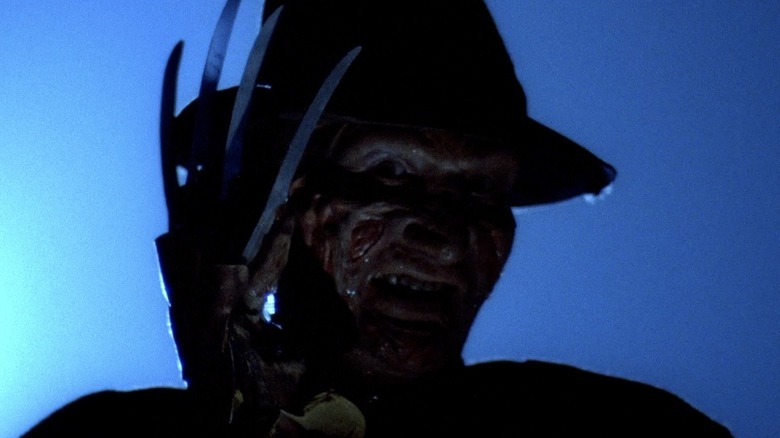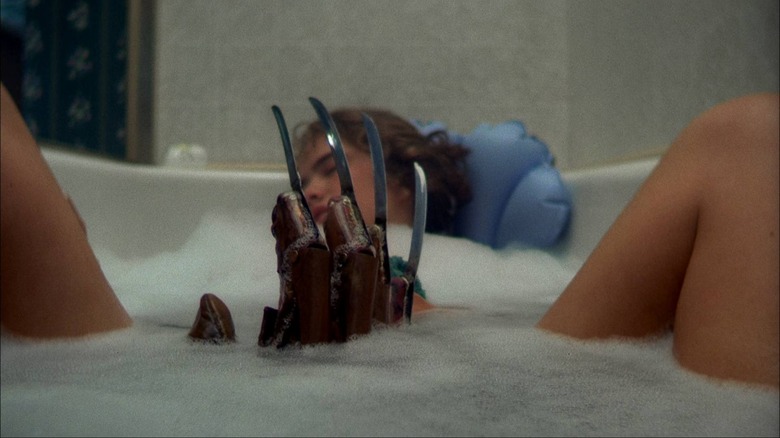The Haunting True Story That Inspired A Nightmare On Elm Street
Filmmakers like the late Wes Craven are often tasked with actualizing dreams, both literal dreams and figurative ones of the type that come to creative people even when they are awake. Craven's contemporary, James Cameron, for instance, famously had the inspiration for "The Terminator" come to him in a nightmare, where he saw "the image of a chrome skeleton emerging from a fire."
"A Nightmare on Elm Street," Craven's first Freddy Krueger film, ripped through movie screens just two weeks after "The Terminator" in 1984. However, while its title and the slasher concept of Krueger — a supernatural killer who stalks suburbanites in their dreams — may involve nightmares, Craven's inspiration was the inverse of Cameron's. It came from a real-life horror, something he had read in the newspaper.
In 2014, Craven took part in a 30th-anniversary oral history of "A Nightmare on Elm Street" for Vulture, where he explained the impetus for his original "Nightmare on Elm Street" script. He said:
"I'd read an article in the L.A.Times about a family who had escaped the Killing Fields in Cambodia and managed to get to the U.S. Things were fine, and then suddenly the young son was having very disturbing nightmares. He told his parents he was afraid that if he slept, the thing chasing him would get him, so he tried to stay awake for days at a time. When he finally fell asleep, his parents thought this crisis was over. Then they heard screams in the middle of the night. By the time they got to him, he was dead. He died in the middle of a nightmare. Here was a youngster having a vision of a horror that everyone older was denying. That became the central line of 'Nightmare on Elm Street.'"
Craven was not coming from a horror background
Craven passed away in 2015, so these are some of the last insights we have from him into the making of his film. For cinephiles in the streaming age, his inspiration for "A Nightmare on Elm Street" may sound reminiscent of the 2020 Netflix film, "His House," in which a refugee couple from South Sudan are terrorized by a supernatural presence in their new home in England. However, Craven's film came decades earlier when the slasher movie genre was in the middle of a Golden Age sparked by John Carpenter's "Halloween."
Craven was friends with Sean S. Cunningham, the director of "Friday the 13th," a franchise that developed along a parallel track of copious sequels and even crossed over with "A Nightmare on Elm Street" at one point in "Freddy vs. Jason." As Craven tells it, he had never seen a horror movie in his life, and it was Cunningham who first encouraged him to write one, which may be why that newspaper article influenced him more than existing horror icons.
In a 2011 interview with The New York Times, Craven talked about growing up in a strict Baptist household with an alcoholic father. Years later, Cunningham pushed him to write from a place he knew and use his fundamentalist background as the basis for a horror script. "That became Last House on the Left," Craven told Vulture, referencing his 1972 directorial debut. He went on to make "The Hills Have Eyes" after that, but his fortunes soon dried up and he developed a drug problem. It was not until getting clean that he set his mind to writing "A Nightmare on Elm Street."
The resulting film became a cultural touchstone for the 1980s and changed the horror genre forever. Craven stepped away from the franchise, though he would return to co-write and produce "A Nightmare on Elm Street 3: Dream Warriors" and eventually both write and direct again with the meta-horror gem, "Wes Craven's New Nightmare." It all happened because of a newspaper article he read, proving that, yes, the real world is sometimes even more frightening than the movies that provide an escape from it.

